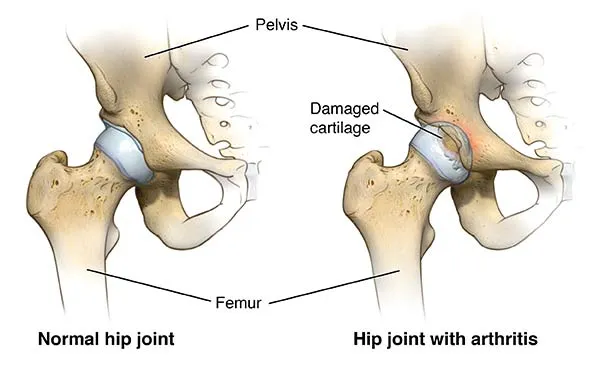Hip replacement surgery, also known as hip arthroplasty, is a surgical procedure in which a damaged hip joint is replaced with an artificial implant (prosthesis) made of high-quality metal or plastic components.
The prosthetic joint generally includes three main parts:
Stem: inserted into the thigh bone (femur)
Ball: attached to the top of the stem
Cup: placed into the hip socket (pelvis)
Like other joints in the body, the hip joint can deteriorate over time due to arthritis, injury, or natural wear and tear. When medications and non-surgical treatments no longer provide relief from pain or stiffness, hip replacement surgery becomes the best option to restore movement and comfort.
There are two main types of hip replacement surgery:
Unilateral Hip Replacement – replacement of one hip joint.
Bilateral Hip Replacement – replacement of both hip joints during the same or separate procedures.

Types of Hip Replacement Surgery
Unilateral Hip Replacement
In this procedure, only one hip joint is replaced.
It is recommended for patients with damage or arthritis in a single hip.
Recovery focuses on restoring strength and mobility in the operated hip.
Bilateral Hip Replacement
Both hip joints are replaced — either simultaneously in a single surgery or staged in two separate procedures.
Suitable for patients with arthritis or joint damage in both hips.
Offers balanced recovery and improved mobility in both legs.
Total Hip Replacement (THR)
The entire hip joint (ball and socket) is replaced with metal and plastic implants.
Provides long-term pain relief and restores normal movement.
Partial Hip Replacement
Only the damaged portion of the hip joint is replaced, preserving healthy bone and tissue.
Often recommended for hip fractures or localized joint damage.
Recovery is usually faster than total hip replacement.
Hip Replacement Surgery Procedure
Hip replacement surgery (hip arthroplasty) involves removing the damaged hip joint and replacing it with artificial implants to restore movement, reduce pain, and improve quality of life.
Step-by-Step Procedure:
Anesthesia
The patient receives either general anesthesia (asleep) or spinal anesthesia (numb from waist down) for a pain-free surgery.
Incision
A surgical incision is made along the hip to access the joint.
Minimally invasive techniques may use smaller cuts for faster recovery.
Removal of Damaged Bone and Cartilage
The surgeon removes the worn-out cartilage and damaged bone from the thigh bone (femur) and hip socket (acetabulum).
Implant Placement
A metal stem is inserted into the thigh bone.
A ball component is attached to the top of the stem.
A cup is placed into the hip socket, with a plastic or ceramic liner to allow smooth movement.
Closure
The incision is closed with sutures or staples, and a sterile dressing is applied.
Recovery and Rehabilitation
Patients often start walking with support within 1–2 days.
Physiotherapy helps strengthen muscles and improve mobility.
Full recovery generally takes 6–12 weeks.
Benefits
Significant pain relief
Improved mobility and joint function
Long-term durability of the artificial joint